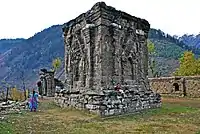Churrio Jabal Durga Mata Temple
| Churrio Jabal Durga Mata Temple | |
|---|---|
 Entrance of Churrio Jabal Durga Mata temple. | |
| Religion | |
| Affiliation | Hinduism |
| District | Tharparkar |
| Deity | Durga |
| Location | |
| Location | Nagarparkar |
| State | Sindh |
| Country | |
 Shown within Sindh | |
| Geographic coordinates | 24°24′01.5″N 71°03′53.0″E |
| Architecture | |
| Type | Hindu temple |
Churrio Jabal Durga Mata Temple (چوڙيو جبل, pronunciation: choo-ryo ja-bal) is situated on a hill named Churrio, located in Nangarparkar in the Tharparkar District in the Sindh province of Pakistan. This is a historic temple and is visited annually by 200,000 pilgrims on Shivratri.[1] Hindus bring cremated ashes of their departed beloveds to immerse in the holy water in the temple.[2] The valuable and multi-coloured hill supporting the temple is mined for its rare and expensive granite, which is posing a serious threat to the temple.[3]
Etymology
.jpg.webp)
The name Churrio (Choryo)[4] is a word from Sindhi language, derived from a word (چوڙي), to be pronounced as (Choo-rree), which means 'a bangle'; thus the word Churrio—an adjective in Sindhi language—means "belonging to/related to bangles",[5] because in the vicinity of the hill there are a number of small villages that have historically remained attached to the profession of manufacturing bangles for women. These locally manufactured bangles are then transported out of the villages to the nearby towns like Nangarparkar up to Mithi in the west and Umerkot in the north. Accordingly, culturally, the women of the area dress in heavily embroidered clothes with bangles adorning their wrists.[6]
Significance

Durga Mata temple, on Churrio Jabal hill in Chorrio village is dedicated to the Hindu goddess Durga,[7] who is attributed as destroyer of evil, triumph of good over evil, the mother of universe, and power behind the creation, preservation, and destruction of the world.[8] Thousands of pilgrims, not only from Pakistan, especially the provinces of Sindh, Baluchistan, Punjab and Khyber Pakhtunkhwa, but also from Nepal, India and other countries visit Churrio Hill for their religious festivals.[9] The temple is a part of Hindu religious and cultural heritage in Sindh, Pakistan.[10] On Shivratri 200,000 pilgrims visit the temples. Hindus cremate the dead and ashes are preserved till Shivratri for immersion in the into holy water. Richer Pakistani Hindus go to India to immerse the ashes in Ganges and the rest visit Nagarparkar to immerse the ashes. However the area has been leased by the government for the mining by dynamite blasting of the hills on which the temples are located. This is posing a threat to the temples. Pilgrims held a protest against the destruction of this area by the miners.[11]
Mining
The Churrio Hill on which the temple exist is formed of granite.[12] Compared to the neighbouring areas of Rajputana in India, where the granite is grey, the granite colour formation in Churrio is multicoloured and hence expensive.[13]
Mining is posing serious danger to the Hindu temples of the area.[7][10][11] The Hindu community protested against the mining.[14] Despite opposition by local Hindus, the digging work is going ahead. Instead of trying to put a stop to the digging activity, the Sindh government has issued a lease to a contractor to carry out the work.[15]
Gallery
.jpg.webp) Churrio Jabal (Churrio Hill)
Churrio Jabal (Churrio Hill).jpg.webp) Way leading to Churrio Jabal temple
Way leading to Churrio Jabal temple Churrio Durga temple is under threat from the dynamite mining
Churrio Durga temple is under threat from the dynamite mining
See also
- Panj Tirath
- Ramapir Temple Tando Allahyar
- Umarkot Shiv Mandir
References
- "Nagarparkar: The land of history and architectural marvels". 16 May 2019.
- "Contractor blasting through Tharparkar temple in search of granite". 9 March 2011.
- "Archived copy" (PDF). Archived from the original (PDF) on 2018-07-13. Retrieved 2016-07-19.
{{cite web}}: CS1 maint: archived copy as title (link) - "Contractor blasting through Tharparkar temple in search of granite - The Express Tribune". 9 March 2011.
- Jam-e-Sindhi-Lughat/Sindhi-Language-Authority/2004
- Agencies (25 September 2014). "Hindus celebrate Navratri and Durga Puja festival".
- "Pvt companys excavation threatens ancient Hindu temple in Pak".
- "Navaratri: The 9 Divine Nights".
- "In search of granite, path to Durga's temple blown up with dynamite".
- "Threat to Durga Mata Temple, Nangarparkar, Sindh". 23 March 2011.
- Contractor blasting through Tharparkar temple in search of granite , The Express Tribune, 10 Mar 2011.
- "Demographic, Social & Economic Changes in Tharparkar" (PDF). Archived from the original (PDF) on 2011-06-01. Retrieved 2016-07-19.
- http://arifhasan.org/wp-content/uploads/2012/08/AH-007_comp-assessment-droughtandfamine.pdf
- "Contractor blasting through Tharparkar temple in search of granite". 9 March 2011.
- "UNPO: Sindh: Shrinking Space of Tolerance".
